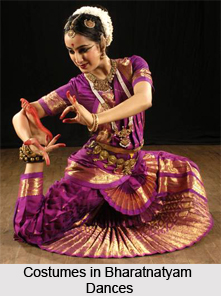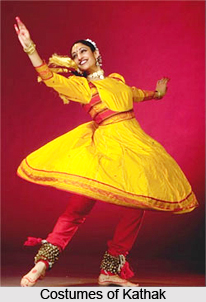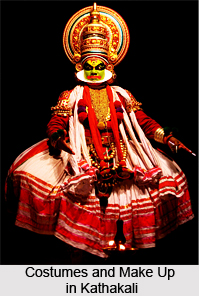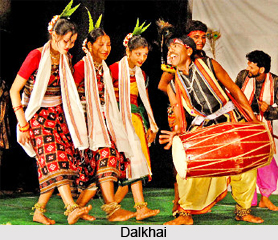Costumes of Indian dances project the chosen attires for the traditional dances and the folk dances.
 Costumes in Bharatnatyam Dance
Costumes in Bharatnatyam Dance
Costumes in Bharatnatyam Dances are gorgeous. The costume consists of a dhoti for both male and female dancers. It is usually of richly embroidered needlework or shimmering silk or satin. Armlets, wristlets or bangles, earrings and necklaces serve to enhance the dancer appearance. Women wear a veni or semi circle of real or artificial flowers round the bun or plait of the hair. In the centre of the forehead a tika or dot is impressed. The most typical items of jewellery are the thalaisaman (headpiece), with the rakodi, worn just above the flowers in the hair, and the Chandrasuryan (moon and sun) on either side, as the head symbolizes the heaven. The ear ornaments consist of three pieces, the maatal (chain), jhimki (hanging earring) and the thodu, which fits on to the lobe.
Costumes in Odissi Dance
The costumes in Odissi dance are elaborate and are similar to that of the traditional Bharatnatyam costume. The women Odissi dancers wear the patta sari, a brightly coloured silk sari which is nine yards long and a black or red blouse called the kanchula, which is embellished with diverse stones and gold and silver thread. An apron-like silk cloth, known as the `nibibhanda`, is tied from the waist like a frill worn around the legs. The waistband, called the jhobha, is a length of cord with tasseled ends. The kanchula of the Gotipuas is quite different as is the method in which the patta sari of Odissi is draped. `Komchila` is the richly embroidered blouse. The decorative headpiece of the dancer is made from Styrofoam, which is shaped like flowers. The headpiece also contains a temple-shaped projecting structure. There are three hairstyles in Odissi dance; namely the ardh-bathaka or semicircular bun; the pushpa-chanda with the hair coiled into the shape of a flower and the kati-beni, which is a single plait down the back. An elaborate design is often made on the forehead with a vermilion mark in the centre. The eyes are decorated with kohl and there is a small mark on the chin. Some contemporary Odissi dancers, however, do not use the authentic costume and ornaments.
 Costumes of Kathak
Costumes of Kathak
The Kathak female dancers wear a Ghaghara, a choli and a veil. For men, the costume includes Dhoti-Kurta or Kameez-Churidar-Vest. Gold and silver ornaments are used for head, neck, arms, hands fingers, waist and feet. Ankle bells are also an essential part of adornment. The tinkling bells not only heighten the movement of the dancing foot and helps in dancing many complex patterns and designs. As per the jewellery, they include: Bangles, Earrings, Hair and Finger ornaments are also used.
In the 16th century tight churidar pyjama appears as a standard dress of Kathak. Even if the dancer wears a full-skirted lehenga, the churidar pyjama below is seen. Prior to the 17th century, the women danced to the beats of the Mridanga and the Manjira. Gradually, there is less inclination to the ardhamandali position and the dancer begins to have a straight and erect posture. The dance could not remain away from the growth and development of north Indian music, specially the khayal. Both the dhrupad and the khayal accompanied the dance. The distinctions between Lasya and Tandava and between Nritta and abhinaya were kept intact in Kathak. This dance-style was given a direction by the Vaishnavite tradition of north India. In the process of making dance an abstract design, the dancer never forgot that it was an invocation to God.
 Costumes and Make Up in Kathakali
Costumes and Make Up in Kathakali
Costume of Kathakali is unique to the core and brings out the delectable epiphany of colourful vibgiors. Costumes of Kathakali preserve its masculine aspect in its elemental vigour. Strong Malayan and Tibetan influences are discerned in the embellishments of the actors. Kathakali Dance forms are noted for its ancient costumes, grand headgears. The costumes used are heavy, intricate, elaborate and colourful. They transform the actor mentally and physically to portray a particular character. The costumes vary with the characters. For instance, the Satvika characters or the hero don different attires as compared to the evil characters. Besides, these characters, such as, Brahmin, righteous women, sages, don the Minukku make up. Tadi is an important part of the make up and costumes used in Kathakali. The costume is used by the performers that make them look like super humans. Mask like designs are painted on the faces of the actors. Different types of white line are used to denote the nature of characters. With such vibrant costumes, it is a visual treat to watch the Kathakali dancers perform on stage. The beautiful costumes of the Kathakali dancers are the essence of the entire performance.
Costumes in Indian Folk Dances
Most of the costumes in Indian folk dances are colourful with all-embracing jewels and designs. Indian folk and tribal dances are performed with the simple motive of expressing joy.
The costume of a Bhangra dancer comprises a bright, coloured Patka on the head, a lacha or lungi of the same colour, a long tunic and a black or blue waistcoat and ghunghroos on the ankles. However, some dancers also wear small rings (nuntian) in their ears.
The costume of another north Indian folk dance, Jhumar is a simple loose shirt. Yet another folk dance of Himachal Pradesh, Namagen is performed by both men and women and the costumes worn by the dancers are usually made of wool and are richly studded. The women wear ample pieces of silver jewellery.
Dumhal of Kashmir is a folk dance performed by the men folk of the Wattal tribe, who wear long colourful robes, tall conical caps that are studded with beads and shells. Other similar folk dances of south India are, Kaalai Attam, where the performers are dressed as a bull, Karadi Attam, where they wear a costume of a bear and Aali Aattam, where the performers dress as a demon.
Vedala Aattam is another folk dance, where the ferocious masks depicting demons is the prime attraction of the costume. Dollu Kunitha or Dollu Dance, a famous folk dance of Karnataka is mainly performed with quick and light movement of the feet and legs. The costumes of the performers are simple. Upper part of the body is usually left bare while the black sheet-rug is tied on the lower part of the body over the `dhooti` or sarong.
Chhau, a mask dance, is a famous folk dance form from eastern India that has fairly known popularity internationally as well. The history of the costume of Chhau dance is not known when this particular dance-form began over two hundred years ago. The contemporary costumes used are of various colours and designs pyjamas of deep green, yellow, or red shade are worn by the artistes who play the gods, while those, who play the demons (asuras) put on loose trousers of a deep black shade. Stripes of contrasting colours are used to make the costumes more striking.
 Dalkhai is the most popular folk-dance of Orissa, performed on occasions like Phangun Puni, Bhaijiuntia, Nuakhai and so on. The women usually dress themselves with the colourful Sambalpuri Sarees and wear a scarf on the shoulders holding the ends below in both the hands. Adorned with traditional ornaments and flowers their full-bodied frames sustain the lively steps for long hours.
Dalkhai is the most popular folk-dance of Orissa, performed on occasions like Phangun Puni, Bhaijiuntia, Nuakhai and so on. The women usually dress themselves with the colourful Sambalpuri Sarees and wear a scarf on the shoulders holding the ends below in both the hands. Adorned with traditional ornaments and flowers their full-bodied frames sustain the lively steps for long hours.
Dandiya, a famous folk dance of Rajasthan is probably the most spectacular sight owing to its unique costume. Women wear dazzling coloured Chaniya Cholis and men wear Kedias. Chaniya Cholis are hand embroidered and embellished with mirrors, shells and anything that matches with it.
Bihu dance is the most popular folk dance of Assam. This dance is performed with traditional folk music played with Dhol and Singor pepea. The costume for this beautiful dance is Dhoti, Gamocha and Chadar for men; Mekhla for women.
Women wear gaudy jewellery and their plaits are filled with flowers. The colour of the flowers is made to match with the dress worn by the dancer. The Thang-ta dance of Manipur was an evolution from the martial arts and the costume is usually white dhoti and loose kurta. The men festoon their waists with colourful scarves that also tighten the dhoti. In North-eastern India, an organised group of tribal performers perform dances, plays, and musical scripts, dance dramas. The dancers wear masks of demons or animals and splendid costumes.




